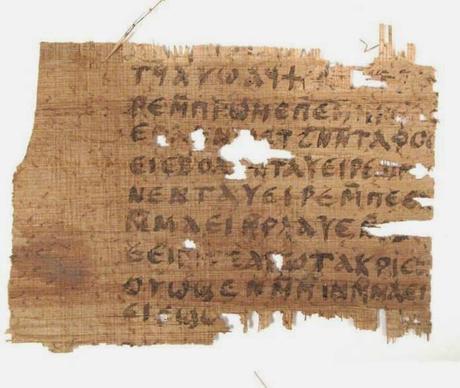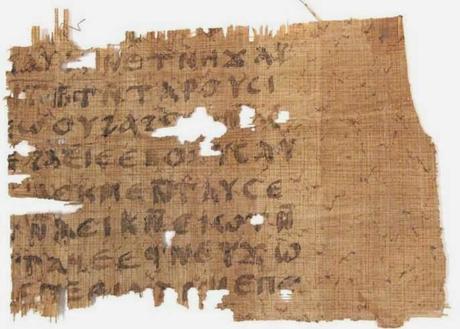Jesus had an ugly sister-in-law
The joke title relates to the fact that since the Jesus' Wife Fragment was released in September 2012, there has been talk of a sister fragment, a Coptic fragment of the Gospel of John. This fragment, along with the Jesus' Wife Fragment, was alleged to have been part of a cache of six fragments, and many of us wondered whether studying this related fragment might help with establishing the authenticity of the Jesus' Wife Fragment. The difficulty, however, was that pictures of this fragment had not been released.
It turns out, however, that the Harvard Divinity School's Website on the Gospel of Jesus' Wife in fact features several much fuller versions of the material tests published in the recent Harvard Theological Review, including a couple of pictures of the hitherto unpublished John fragment, one in the Ink Study page, specifically James Yardley's report (PDF), and one in the Infrared Microspectroscopy page, specifically Timothy Swager's report (PDF).
The images of the fragment of John are revealing. I am extracting them here from the PDF of Swager's report, which has the superior pictures:


Those of us who have spent a lot of time staring at the Jesus' Wife Fragment will have found it an eery experience to have laid eyes, finally, on this related fragment today. It is remarkable just how similar the hand is here, as Christian Askeland points out. Moreover, the text of the manuscript appears to replicate the text of Herbert Thompson, The Gospel of St. John According to the Earliest Coptic Manuscript (London: British School of Archaeology in Egypt, University College, 1924), line breaks and all.
Askeland's astute observations are corroborated and echoed by Alin Suciu:
Christian Askeland finds the "Smoking Gun"
Suciu helpfully lays out the parallels between the verso of the fragment (above) and Thompson's edition. I've checked the verso and the same is true for that too. (I'll post an illustration tomorrow if anyone is interested). Leo Depuydt has also been in touch today to say that he has checked up on the parallels and it is clear to him too -- this fragment is copied from Thompson's edition.
Like Grondin's Interlinear Gospel of Thomas on which the Jesus' Wife Fragment appears to depend, Thompson's 1924 edition is also available online.
The point, of course, is that if this fragment of John, in the same hand as the Jesus' Wife fragment, is clearly copied from a modern edition of an ancient manuscript, it makes a mockery of the idea that the Jesus' Wife Fragment could be genuine. Moreover, as Christian Askeland explains:
Essentially all specialists believe that Lycopolitan and the other minor dialects died out during or before the sixth century. Indeed, the forger tried to offer two manuscripts both in Lycopolitan, but made two crucial mistakes. First, the NHC gospel of Thomas is not a pure Lycopolitan text, but the Qau codex is. That is we have two clearly different subdialects of Lycopolitan, which agree exactly with published texts. Second, this GJohn fragment has been 14C dated to the seventh to ninth centuries, a period from which Lycopolitan is totally unknown.I should make clear that unlike Christian Askeland, Alin Suciu and Leo Depuydt, I have no expertise in these manuscripts and dialects. But not only do I trust their judgment but also I have carefully studied the Thompson edition and this fragment of John and there seems little doubt to me that the one is copied from the other. Kudos to Askeland, who was suspicious of the Jesus' Wife Fragment from the first, for taking the time to investigate this further and for sharing his expertise.
I am hoping to comment on these developments, and others, in due course, but one quick thought at this point: a great deal of time could have been saved by releasing images of this John fragment back in 2012. It is material evidence in the case. Even now, the pictures have only been released inadvertently as part of a study of the ink, not in order for the manuscript and language experts to study them. I'd like to ask now, again, for a full release of all the other related materials -- the other four manuscripts in this cache as well as the associated back-story materials.
